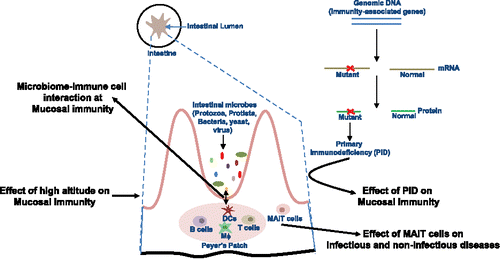Mucosal surfaces in the host are the largest surfaces that are continuously exposed to numerous microbes and foreign antigens; however, in healthy individuals, this does not induce immune reactions. Moreover, mucosal surfaces, particularly, in the gastrointestinal tract play a pivotal role in various complex biological processes such as food digestion/absorption, absorption of vitamins synthesized by commensal microbes, and induce required immune responses to eliminate enteric pathogens. Maintaining the delicate balance of immune tolerance against commensal microbe and immune reaction against pathogenic microbe along with non-immunological processes is a hallmark of gut immunity. Immune response in the gut is mediated by various mucosa-associated lymphoid structures, lymphoid/non-lymphoid cells, and soluble factors such as Peyer's patch, paneth cells, and immunoglobulin A, respectively. This issue of the International Reviews of Immunology describes the interaction of gut microbiome and gut immune cells with gut mucosa during enteric disease and how immune deficiency impacts gastrointestinal health in pediatric patients. This issue also discusses the impact of high altitudes on mucosal immunity ().
The microbiota permanently colonize in the gut of the host and consist of several microbial species belonging to species such as Protozoa, Protista, Bacteria, Fungi, and Viruses, and this heterogeneous and complex ecosystem within the gut is essential for normal physiology of the healthy host. The first review articles of this issue by Liua et al. discuss how microbial population and its product influence the maturation of the immune system at mucosal and non-mucosal sites. Additionally, the review discusses the link of microbial population and epigenetic modifications during development and maturation of immune cells. The authors also suggested how the commensal microbes can be used in treatment and prevention of gut-associated diseases ().
Various cells such as goblet cells, paneth cells, microfold (M) cells are unique to the mucosal sites. These cells play an indispensable role in immune defense through unique function in the gut for elimination of enteric microbial pathogens and maintenance of colonies of commensal microbes. The second review article by Ahmad et al. focuses on mucosa-associated invariant T (MAIT) cells, which are predominantly present in mucosal sites and induce cell death in microbial infected cells. These cells are also involved in the induction of various degrees of inflammation and induce chronic to acute diseases. The review article provides an update of MAIT cells in infectious and non-infectious disease biology and may help in the development of novel therapeutics ().
Figure 1. Intrinsic and extrinsic factors affecting Gut microbiome and immune cells interaction at gastrointestinal tract: Macrophages, M; Dendritic cells, DCs; Mucosa-associated invariant T (MAIT) cells.

Gene mutation or deletion may take place during cell division and can cause mild reduction to complete loss of gene function, or in rare cases can cause an increase in function. The mutation in immune gene(s) led to the partial to complete immunocompromised state, depending on the gene and/or the site of mutation within a gene. The third review article by Ladomenou et al, discusses, how immune deficiency affects the gut system in pediatric patients. The review article may help Medical practitioners, including clinical immunologist and pediatricians, by providing basic understanding and better management of immunocompromised pediatric patients. ().
The physiology of organisms, including host immunity, changes with various environmental parameters such as gravity, altitude, temperature, pressure, and availability of oxygen. The changes in immunity may result in changes in susceptibility to various infections. The last review article of this issue by Singh et al. describes the impact of high altitude on gut immunity. This review article can be helpful in understanding host immunity in altered environmental conditions, and provides information to manage diseases in these conditions ().
Additional information
Funding
References
- Yu Q, Jia A, Li Y, et al. Microbiota regulate the development and function of the immune cells. Int Rev Immunol. 2018;37(2):79–89.
- Kumar V, Ahmad A. Role of MAIT cells in the immunopathogenesis of inflammatory diseases: New players in old game. Int Rev Immunol. 2018;37(2):90–110.
- Nazi N, Ladomenou F. Gastrointestinal manifestations of primary immune deficiencies in children. Int Rev Immunol. 2018;37(2):111–118.
- Khanna K, Mishra KP, Ganju L. High Altitude Induced Alterations in Gut-Immune Axis: A Review. Int Rev Immunol. 2018;37(1):119–126.
